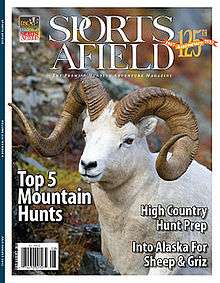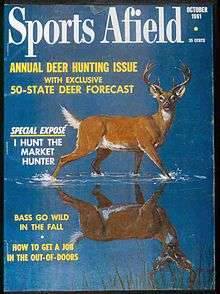Sports Afield
 A 2012 Sports Afield magazine cover. | |
| Editor in Chief | Diana Rupp |
|---|---|
| Frequency | Bimonthly |
| Year founded | 1887 |
| Company | Field Sports Publishing Inc |
| Country | United States |
| Based in | Huntington Beach, California[1] |
| Language | English |
| Website |
www |
| ISSN | 0038-8149 |
Sports Afield (SA) was founded in 1887[1] by Claude King, as a hunting and fishing magazine, and it is the oldest continuously published outdoor magazine in North America. The first issue, in January 1888, was eight pages long; it was printed on newspaper stock and published in Denver, Colorado. Together with Outdoor Life and Field & Stream, it is one of the Big Three in American outdoor magazines. Initially only a magazine, Sports Afield started applying its name on branded products after WW II. This program greatly expanded in the 21st century, and the Sports Afield Brand is now available on dozens of products such as back packs, camping equipment, clothing, household decorations, knives, sunglasses, vault-type safes, and even log cabins.
"Journal for Gentlemen"
The “Journal for Gentlemen” promised, in King’s words, “To be devoted to hunting, fishing, rifle and trap shooting, the breeding of thorough-bred dogs, cycling, and kindred sports…” The subscription price was $1.50 per year, with single copies selling for 15 cents. A few years later, King expounded on his philosophy: “Sports Afield has an ambition above that of simply entertaining and amusing the public; it wants to help propagate the true spirit of gentle sportsmanship, to encourage indulgence in outdoor recreations, and to assist in the dissemination of knowledge regarding natural history, photography, firearms, and kindred subjects.”
Before the decade was out, Sports Afield had expanded and moved its operations to Chicago. The magazine grew, with some issues running 96 pages. It soon became not only a voice of the American West, but as well a spokesman for campers, fishermen, hunters, and shooters across the United States of America. By 1927, when King stepped down as editor and turned the reins over to Joe Godfrey, Sports Afield was in full stride. Zane Grey started writing for the magazine, as did Jimmy Robinson, beginning a 60-year association with the publication. In 1930, Ivan B. Romig and his associates took over Sports Afield, combined it with a smaller publication—Trails of the Northwoods—and moved the offices to Minneapolis. A string of editors worked the helm of Sports Afield, which struggled during the Great Depression years to stay afloat. It did, and by 1934 the magazine was in the black.

Sports Afield was an early advocate of the wise use of the earth’s resources, trying to make the public aware of environmental concerns. Its credo was: “We believe in sane conservation, we oppose pollution, and we stand for the enforcement of our game laws.” In the 1930s, Gordon MacQuarrie and Archibald Rutledge joined as writers, and the circulation rose to 250,000. In 1945, Ted Kesting, an associate editor of Country Gentleman magazine, was hired as editorial director and brought from Philadelphia to Minneapolis. His assignment was to expand and modernize Sports Afield. Only 26 years of age, he was the youngest editor of a major national publication in the United States.
Kesting soon signed up more writers. One he brought on board was angling editor Jason Lucas, whose writings about bass fishing became very popular. Another was mystery writer Erle Stanley Gardner, who became known for his articles defending gun owners' and hunters’ rights. By October 1948, TIME reported that Sports Afield had become the biggest of all outdoor monthlies. "Last week it put to bed a November issue that would go to 800,000 customers, a record for its sixty-one years. Colorful as a hatband full of flies, it was filled with picture stories and crackling adventure stuff…”
Purchase by Hearst

In 1953, Hearst magazines tendered an offer to Walter Taylor, the publisher, providing Kesting and his staff came along. The sale was made, and Sports Afield moved its offices to New York City. Meanwhile, the magazine continued to grow, attracting such writers as Col. Townsend Whelen, Jack Denton Scott, and Russell Annabel. Circulation hit the 1,100,000 mark in 1961. By the late 1960s, Homer Circle, Tom Paugh, and Zack Taylor had joined the ranks. The cover price jumped from 35 cents to 50 cents a copy.
In 1970, Kesting announced he was stepping down as editor and named Lamar Underwood as his replacement. Under Underwood’s guidance, Gene Hill, Nick Lyons, Vance Bourjaily, and John Madson all appeared in the periodical’s pages. The Almanac came into existence in 1972.
When Underwood moved on, he was replaced by saltwater fishing editor Tom Paugh. The Paugh years saw major redesigns, plus a downsizing in circulation as the magazine adjusted to competitive times. Grits Gresham, Thomas McIntyre, Ted Kerasote, and Anthony Acerrano all wrote for the magazine, which continued to publish not only adventure stories mixed with how-to-do-it pieces but also to comment on conservation issues as well.
The Magazine Today
In the late 1990s, the magazine entered the most difficult period in its long history. Hearst executives shifted the magazine’s focus from hunting and fishing to camping, hiking, mountain biking,and other “non-consumptive” outdoor sports. The gambit failed, however, and in the summer of 2000, Hearst sold the magazine to Robert E. Petersen, who subsequently moved the magazine’s offices to the Los Angeles area.
In the summer of 2002, Field Sports Publishing Inc. (FSP) purchased the rights to publish the magazine from Bob Petersen. FSP is owned by the same investor group that owns the book publishing company Safari Press. The owners decided to return Sports Afield to its original core and focus the magazine on the traveling big-game hunter. Diana Rupp became the new editor. In 2009 the remaining intellectual property rights to the Sports Afield name were purchased by FSP, and today Sports Afield its is one of a few outdoor magazines with a high profile name that owns all the rights to its name.
Sports Afield Brand
Besides publishing the Sports Afield magazine, the parent company is engaged in licensing the Sports Afield name for selected goods and services. In the spring of 2010, the owners of Sports Afield announced a licensing deal with SCP, a privately held television-production company based in Dallas, to launch The World of Sports Afield TV show on The Sportsman Channel. In addition, licensing deals for clothing, camping equipment, and old Sports Afield magazine cover art have since taken place. In the Spring of 2013, FSP had made a licensing deal for a line of Sports Afield safes which are being sold via Costco, among other retailers. In 2013, the Sports Afield announced a series of log cabins in conjunction with Whisper Creek Log Homes from Montana. Other licensing deals have been announced by the company for flashlights, knives, leather boots, rubber boots, and many other articles and goods related to outdoor living and a classic style. In March 2014, the company bought the real-estate marketing company Cabela's Trophy Properties, which sells outdoor ranches, estates, and land, and renamed it Sports Afield Trophy Properties.
The magazine turned 125 years old in 2012.
References
- 1 2 Robert Lee Brewer (31 August 2014). 2015 Writer's Market. "F+W Media, Inc.". p. 634. ISBN 978-1-59963-840-9. Retrieved 9 May 2016.
- "Our History, Founded in 1887". Sports Afield.